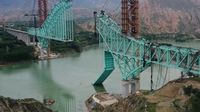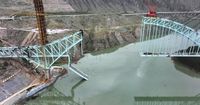In the early hours of August 22, 2025, tragedy struck in northwest China’s Qinghai province when a railway bridge under construction collapsed, claiming the lives of at least 12 construction workers and leaving four others missing. The incident, which unfolded around 3 a.m., has sent shockwaves through the local community and raised urgent questions about construction safety standards in one of China’s rapidly developing regions.
According to state media reports cited by the Associated Press and China Daily, the catastrophic event occurred during a tensioning operation—a crucial phase in bridge construction—when a steel cable suddenly snapped. Sixteen workers were on the bridge at the time, laboring high above the Yellow River, which snakes its way through the heart of Qinghai. The bridge itself, an ambitious 1.6-kilometer (just about a mile) span, was designed to stand 55 meters (180 feet) above the river’s surface.
Aerial photographs provided by the official Xinhua News Agency paint a stark picture of the aftermath: a gaping void in the bridge’s once-elegant, curved aquamarine arch, with a twisted section of the deck now dangling precariously into the river below. The scene has become a chilling symbol of both the risks faced by construction workers and the immense challenges of building infrastructure in difficult terrain.
As news of the collapse broke, emergency response teams sprang into action. Search efforts, as reported by China Daily, have been extensive and technologically advanced, involving a fleet of boats, a helicopter, and even robotic devices scouring the turbulent waters and debris-strewn banks of the Yellow River. The scale and urgency of the rescue operation underscore the gravity of the incident and the slim hopes that those still missing might be found alive.
For the families of the workers, the hours since the collapse have been harrowing. With four people still unaccounted for, the sense of loss and uncertainty hangs heavy in the air. The identities of the victims have not yet been released, pending notification of relatives, but local authorities have pledged to provide support and compensation to those affected.
The bridge, a key component of the region’s expanding railway network, was intended to boost connectivity and economic growth in Qinghai, a province known for its vast plateaus and strategic location along China’s Belt and Road Initiative. Its construction was seen as a symbol of progress—until the disaster transformed it into a somber reminder of the human cost that sometimes accompanies such ambitions.
While industrial accidents are not uncommon in China, the circumstances of this collapse have drawn particular scrutiny. The fact that a steel cable could snap during a routine tensioning operation raises concerns about the quality of materials, the rigor of safety protocols, and the pressures faced by workers and contractors to meet tight deadlines. Construction in remote and challenging environments like Qinghai often compounds these risks, with workers laboring in difficult conditions far from urban centers and emergency services.
Chinese authorities have not yet released an official statement on the cause of the collapse, but an investigation is reportedly underway. The use of advanced search technology—boats, helicopters, and robots—reflects both the difficulty of the rescue operation and the government’s determination to demonstrate a robust response. However, for many observers, these efforts also highlight the need for more proactive measures to prevent such tragedies in the first place.
The collapse has also reignited debate about the pace and scale of infrastructure development in China. With the country’s ambitious plans to modernize transportation networks and spur economic growth, construction projects have proliferated across the nation, from gleaming urban skyscrapers to remote mountain railways. While these projects have delivered undeniable benefits, they have also exposed workers to significant hazards, sometimes with deadly consequences.
Safety advocates point to a pattern of accidents in the construction sector, urging tighter regulation, more rigorous inspections, and better training for workers. They argue that while technological advances—such as the use of robots in rescue operations—are welcome, they cannot substitute for a strong safety culture and robust oversight. As one local official, speaking to China Daily under condition of anonymity, put it: “Every accident is a lesson paid for in blood. We must do better to protect those who build our future.”
For the workers themselves, the risks are all too real. Many are migrants from rural areas, drawn by the promise of steady pay but often unfamiliar with the dangers of large-scale construction. They work long hours in sometimes harsh conditions, relying on the expertise of supervisors and the integrity of the materials and equipment provided. When something goes wrong, as it did in Qinghai, the consequences can be swift and devastating.
The Qinghai bridge collapse is not the first such incident in China’s recent history, but its high-profile nature and the advanced technology deployed in the rescue have brought renewed attention to the issue. The public, too, has responded with a mixture of grief and frustration, with many taking to social media to express condolences and demand accountability. Calls for transparency and a thorough investigation have echoed across platforms, reflecting a growing expectation that authorities will address not just the immediate aftermath but also the underlying causes.
In the days ahead, the focus will likely shift from rescue to recovery, and from mourning to reckoning. The families of the victims will seek answers—and, perhaps, justice—for their loved ones. The government faces the twin challenges of managing public sentiment and ensuring that such tragedies do not recur. For the wider construction industry, the collapse is a stark warning that safety must never be sacrificed on the altar of speed or profit.
As the search for the missing continues, the ruined bridge over the Yellow River stands as both a monument to human ambition and a reminder of its limits. The hope, voiced by many in Qinghai and beyond, is that the lessons learned from this disaster will lead to safer practices and a renewed commitment to protecting the lives of those who build the nation’s future.






